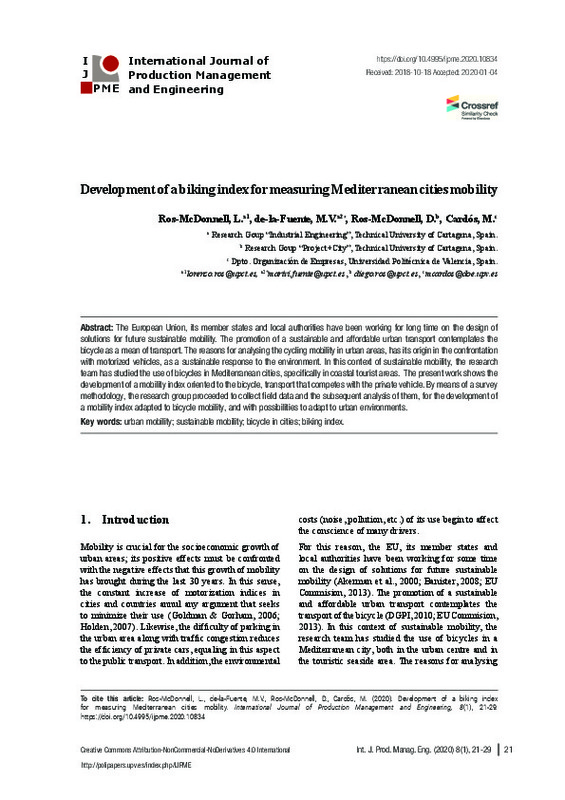Akerman, J., Banister, D., Dreborg, K., Nijkamp, P., Schleicher-Tappeser, R., Stead, D., Steen P. (2000). European Transport Policy and Sustainable Mobility. Ed. Routledge, Taylor & Francis Group. https://doi.org/10.4324/9780203857816
Banister, D. (2008). The sustainable mobility paradigm . Transport Policy, 15(2), 73-80. https://doi.org/10.1016/j.tranpol.2007.10.005
Botma, H. (1995). Method to determine level of service for bicycle paths and pedestrian-bicycle paths. Transportation Research Record: Journal of the Transportation Research Board, 1502, 38-44.
[+]
Akerman, J., Banister, D., Dreborg, K., Nijkamp, P., Schleicher-Tappeser, R., Stead, D., Steen P. (2000). European Transport Policy and Sustainable Mobility. Ed. Routledge, Taylor & Francis Group. https://doi.org/10.4324/9780203857816
Banister, D. (2008). The sustainable mobility paradigm . Transport Policy, 15(2), 73-80. https://doi.org/10.1016/j.tranpol.2007.10.005
Botma, H. (1995). Method to determine level of service for bicycle paths and pedestrian-bicycle paths. Transportation Research Record: Journal of the Transportation Research Board, 1502, 38-44.
Bulkeley, H., Betsill, M.M. (2005). Rethinking sustainable cities: Multilevel governance and the Urban politics of climate change. Environmental Politics,14(1), 42-63. https://doi.org/10.1080/0964401042000310178
Copenhagenize Index (2011). https://copenhagenizeindex.eu
DGPI (2010). Fomento del transporte en bicibleta. Dirección General de Políticas Interiores - Transporte y Turismo, Parlamento Europeo.
Dill, J. (2009). Bicycling for transportation and health: the role of infrastructure. Journal of Public Health Policy, 30, 95-110. https://doi.org/10.1057/jphp.2008.56
ECF (2017). EU Cycling Strategy. Recommendations for Delivering Green Growth and an Effective Mobility in 2030. https://ecf.com/eu_cycling_strategy
Eurobarometer (2014). Attitudes on Issues related to EU Transport Policy.
European Commission (1999). Cycling: The Way Ahead for Towns and Cities (European Commission, Brussels).
European Commission (2013). Civitas Initiative, https://www.civitas-initiative.eu.
Ewing, R., Schmid, T., Killingsworth, R., Zlot, A., & Raudenbush, S. (2003). Relationship between urban sprawl and physical activity obesity and morbidity. American Journal of Health Promotion, 181, 47-57. https://doi.org/10.4278/0890-1171-18.1.47
Ewing, R., Handy, S., Brownson, R., Clemente, O., Winston, E. (2006). Identifying and measuring urban design qualities related to walkability. Journal of Physical Activity and Health, 3, 223-240. https://doi.org/10.1123/jpah.3.s1.s223
Flowerdew, R., Manley, D., Sabel, C. E. (2008). Neighbourhood effects on health: does it matter where you draw the boundaries? Social Science and Medicine, 666, 1241-1255. https://doi.org/10.1016/j.socscimed.2007.11.042
Forsyth, A., Oakes, J., Schmitz K., Hears, M. (2007). Does residential density increasing walking and other physical activity? Urban Studies, 44, 679-697. https://doi.org/10.1080/00420980601184729
Frank, L., Sallis, J., Saelens, B., Leary, L., Cain, K., Conwa, T., Hess, P. (2009) The development of a walkability index: application to the neighborhood quality of life study. British Journal of Sports Medicine, 44, 924-933. https://doi.org/10.1136/bjsm.2009.058701
GEOSP (2017). Barómetro de la bicicleta en España. Informe de resultados 2017.
Goldman, T., Gorham, R. (2006). Sustainable urban transport: four innovative directions. Technology in Society, 28(1-2), 261-273. https://doi.org/10.1016/j.techsoc.2005.10.007
Gutierrez, C., Gu, S., Karam, L., Thomas, T. (2017). Measuring and Evaluating Bikeability in San Francisco. In URBANST 164: Sustainable Cities, 3-29.
Hartanto, K., Grigolon, A., Maarseveen, M., Brussel, M. (2017). Developing a bikeability index in the context of transit-oriented development (TOD). In: 15th International Conference on Computers in Urban Planning and Urban Management (CUPUM), Adelaide (Australia).
Holden, E. (2007). Achieving sustainable mobility: everyday and leisure-time travel in the EU. Ed. Ashgate Publishing.
Hydén, C., Nilsson, A., Risser, R. (1998). How to enhance walking and cycling instead of shorter car trips and to make these modes safer. In: Institutionen för Trafikteknuk, Lunds Tekniska Högskola, n° 165.
Jensen, S.U. (2007). Pedestrian and bicyclist level on roadway segments. Transportation Research Record: Journal of the Transportation Research Board, 2031, 43-51. https://doi.org/10.3141/2031-06
Pucher, J., Dijkstra, P. (2003) Promoting safe walking and cycling to improve public health: lessons from the Netherlands and Germany. American Journal of Public Health, 939, 1509-1516. https://doi.org/10.2105/AJPH.93.9.1509
Krambeck, H.V. (2006). The Global Walkability Index. MIT.
Krenn, P.J., Oja, P., Titze, S. (2015). Developing a bikeability index to score the biking friendliness of urban environments. Open Journal of Civil Engineering, 5, 451-459. https://doi.org/10.4236/ojce.2015.54045
Lowry, M. B., Callister, D., Gresham, M., Moore, B. (2012). Assessment of communitywide bikeability with bicycle level of service. Transportation Research Record, Journal of the Transportation Reserach Board, 2314, 41-48. https://doi.org/10.3141/2314-06
Marqués, R., Hernández-Herrador, V., Calvo-Salazar, M., García-Cebrián, J. A. (2015). How infrastructure can promote cycling in cities: Lessons from Seville. Research in Transportation Economics, 53. https://doi.org/10.1016/j.retrec.2015.10.017
Mesa, V. G., Barajas, D. E. P. (2013). Cali bikeability index map : A tool for evaluating public investment and future needs. Journal of Transport Geography, 4(1), 5-8.
Miralles, C., Cebollada, A. (2003). Movilidad y transporte. Opciones políticas para la ciudad. Fundación alternativas.
Muñuzuri, J., Cortés, P., Onieva, L., Guadix, J. (2000). Modelling Freight Delivery Flows: Missing Link of Urban Transport Analysis. Journal of Urban Planning and Development, 135(3), September 2000. https://doi.org/10.1061/(ASCE)UP.1943-5444.0000011
Nijkamp, P., Reggiani, A., Tritapepe, T. (1996). Modelling inter-urban transport flows in Italy: A comparison between neural network analysis and logit analysis. Transportation Research Part C: Emerging Technologies, 4(6), 323-338. https://doi.org/10.1016/S0968-090X(96)00017-4
Rodriguez, G., Alonzo, L. (2005). Carreteras. Ed. UPM.
Ros-McDonnell, L., de-la-Fuente, M.V., Ros-McDonnell, D., Cardós, M. (2018). Analysis of freight distribution flows in an urban fuctional area. Cities, 79, 159-168. https://doi.org/10.1016/j.cities.2018.03.005
Sanchez, M. (2016) Metodología para la evaluación de la ciclabilidad de una red urbana de carriles bici. Aplicación en la ciudad de Málaga. XVII Congreso Nacional de Tecnologías de Información Geográfica (Málaga)
Santos, L., de las Rivas, J.L. (2008). Ciudades con atributos: conectividad, accesibilidad y movilidad. Revista Ciudades, 11, 13-32.
Sanz, A. (1997). Movilidad y accesibilidad: un escollo para la sostenibilidad urbana. In http://habitat.aq.upm.es/cs/p3/a013.html.
Vale, D., Saraiva, M., Pereira, M. (2016). Active accessibility: A review of operational measures of walking and cycling accessibility. The Journal of Transport and Land Use, 9, 209-235. https://doi.org/10.5198/jtlu.2015.593
Winters, M., Brauer, M., Setton, E., Teschke, K. (2013). Mapping bikeability: a spatial tool to support sustainable travel. Environment and Planning B: Planning and Design, 40(5), 865-883. https://doi.org/10.1068/b38185
Winters, M., Teschke, K., Brauer, M., Fuller, D. (2016). Bike Score: Associations between urban bikeability and cycling behaviour in 24 cities. International Journal of Behavioral Nutrition and Physical activity, 13(18), 1-10. https://doi.org/10.1186/s12966-016-0339-0
[-]









